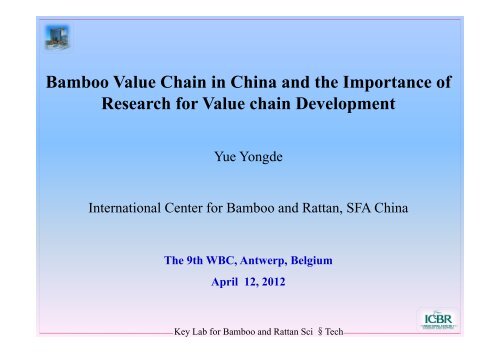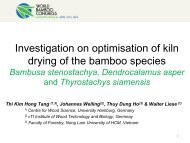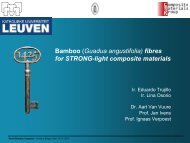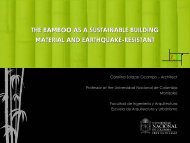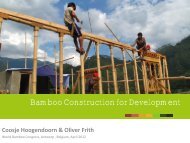Bamboo Value Chain in China and the Importance ... - World Bamboo
Bamboo Value Chain in China and the Importance ... - World Bamboo
Bamboo Value Chain in China and the Importance ... - World Bamboo
Create successful ePaper yourself
Turn your PDF publications into a flip-book with our unique Google optimized e-Paper software.
<strong>Bamboo</strong> <strong>Value</strong> <strong>Cha<strong>in</strong></strong> <strong>in</strong> Ch<strong>in</strong>a <strong>and</strong> <strong>the</strong> <strong>Importance</strong> of<br />
Research for <strong>Value</strong> cha<strong>in</strong> Development<br />
Yue Yongde<br />
International Center for <strong>Bamboo</strong> <strong>and</strong> Rattan, SFA Ch<strong>in</strong>a<br />
Th The 99th h WBC WBC, AAntwerp, BBelgium l i<br />
April 12, 2012<br />
Key Lab for <strong>Bamboo</strong> <strong>and</strong> Rattan Sci §Tech
OOverview i of f <strong>Bamboo</strong> B b Utilization U ili i<br />
<strong>in</strong> Ch<strong>in</strong>a<br />
Key Lab for <strong>Bamboo</strong> <strong>and</strong> Rattan Sci §Tech
<strong>Bamboo</strong> <strong>Bamboo</strong> Resources <strong>in</strong> Ch<strong>in</strong>a Ch<strong>in</strong>a<br />
� Ch<strong>in</strong>a is one of <strong>the</strong> bamboo distribution centers <strong>in</strong> <strong>the</strong><br />
world world, with <strong>the</strong> largest area area, <strong>the</strong> most abundant species<br />
<strong>and</strong> biomass.<br />
�� There are about 39 genera genera, more than 590 species <strong>in</strong><br />
Ch<strong>in</strong>a with 5.38 million hectares of pure bamboo forest,<br />
which accounts for 25% of <strong>the</strong> bamboo area <strong>in</strong> <strong>the</strong> world.<br />
Key Lab for <strong>Bamboo</strong> <strong>and</strong> Rattan Sci §Tech
<strong>Bamboo</strong> forest<br />
AArea: 55.38 38 million illi hectares h t<br />
Genera: 39<br />
Species: 598<br />
Monopodial Sympodial Amphipodial O<strong>the</strong>rs<br />
Genus: 7 Genus: 15 Genus: 9 Genus: 8<br />
Species: 103 Species: 192 Species: 107 Species: 196<br />
MMoso bamboo b b<br />
Area: 3.71 million hectares<br />
PProportion: ti 69.4% 69 4%<br />
Key Lab for <strong>Bamboo</strong> <strong>and</strong> Rattan Sci §Tech<br />
O<strong>the</strong>r bamboo<br />
Area: 1.67 million hectares<br />
Proportion: p<br />
30.6%
Monopodial bamboo<br />
region <strong>in</strong> north of<br />
High<br />
Yangtze River<br />
mounta<strong>in</strong>ous<br />
bamboo region<br />
<strong>in</strong> southwest<br />
Mixed monopodial <strong>and</strong><br />
part<br />
sympodial di l bamboo b b<br />
region <strong>in</strong> south of<br />
Yangtze River<br />
Climb<strong>in</strong>g bamboo<br />
region <strong>in</strong> Ha<strong>in</strong>an,<br />
Sympodial bamboo<br />
Yunnan <strong>and</strong><br />
region <strong>in</strong> sou<strong>the</strong>rn<br />
Sichuan Prov<strong>in</strong>ces<br />
part<br />
�<strong>Bamboo</strong> �<strong>Bamboo</strong> is distributed <strong>in</strong> <strong>the</strong> 27 prov<strong>in</strong>ces of Ch<strong>in</strong>a Ch<strong>in</strong>a.<br />
� Five bamboo distribution regions could be partitioned <strong>in</strong> Ch<strong>in</strong>a.<br />
Key Lab for <strong>Bamboo</strong> <strong>and</strong> Rattan Sci §Tech
600<br />
500<br />
400<br />
300<br />
200<br />
100<br />
0<br />
竹林面积(万公顷)<br />
Unit: 10 thous<strong>and</strong>s hm2 1990-2010<br />
304<br />
19973-1976<br />
Before 1990<br />
356.63<br />
319.96<br />
19977-1983<br />
19984-1988<br />
379.08<br />
19989-1993<br />
421.08<br />
19994-1998<br />
484 484.26 26<br />
19999-2003<br />
538.1<br />
The change of pure bamboo forest area <strong>in</strong> Ch<strong>in</strong>a from 1976‐2008<br />
� The area of pure bamboo forest <strong>in</strong> Ch<strong>in</strong>a <strong>in</strong>creased from 3.04 million<br />
to 5.38 million hm2 from 1976-2008;<br />
� The area of bamboo forest area <strong>in</strong>creased by about 100 thous<strong>and</strong>s<br />
hm2 /year s<strong>in</strong>ce 1990, almost two times of <strong>the</strong> annual <strong>in</strong>crease <strong>in</strong> <strong>the</strong><br />
1980’s. 980 s.<br />
Key Lab for <strong>Bamboo</strong> <strong>and</strong> Rattan Sci §Tech<br />
20004-2008
160000<br />
140000<br />
120000<br />
100000<br />
80000<br />
60000<br />
40000<br />
20000<br />
0<br />
1978<br />
1979<br />
竹材产量(万根)<br />
Unit: 10 thous<strong>and</strong>s culms<br />
Before 1990 1990-2000<br />
1980<br />
1981<br />
1982<br />
1983<br />
1984<br />
1985<br />
1986<br />
1987<br />
1988<br />
1989<br />
1990<br />
1991<br />
1992<br />
1993<br />
1994<br />
1995<br />
1996<br />
1997<br />
1998<br />
1999<br />
2000-2010<br />
2000<br />
2001<br />
2002<br />
2003<br />
2004<br />
2005<br />
The production of bamboo culms from 1978‐2010 <strong>in</strong> Ch<strong>in</strong>a<br />
2006<br />
2007<br />
2008<br />
2009<br />
� The production of bamboo culms <strong>in</strong> Ch<strong>in</strong>a changed little from 1978 to<br />
1990 1990, bbut significantly i ifi l speeded ddup ddur<strong>in</strong>g i <strong>the</strong> h next20 20 years ddue to <strong>the</strong> h<br />
<strong>in</strong>dustrial utilization of bamboo, especially from 2000.<br />
Key Lab for <strong>Bamboo</strong> <strong>and</strong> Rattan Sci §Tech<br />
2010
<strong>Bamboo</strong> Industry<br />
� The development of Ch<strong>in</strong>a bamboo <strong>in</strong>dustry can be divided<br />
<strong>in</strong>to three stages:<br />
• Traditional utilization (before 1990)<br />
• h<strong>and</strong>icrafts h<strong>and</strong>icrafts, woven articles articles, Scaffold<strong>in</strong>gs<br />
• Industrial utilization1990-2000 ()<br />
• bamboo plywood, bamboo floor<strong>in</strong>gs et al<br />
• Comprehensive <strong>and</strong> value-added utilization (2000-)<br />
• bbamboo b scrimber, i b bbamboo b structural t t lllumber, b<br />
bamboo textiles, bamboo carbon et al<br />
Key Lab for <strong>Bamboo</strong> <strong>and</strong> Rattan Sci §Tech
Billion USD U<br />
14<br />
12<br />
10<br />
8<br />
6<br />
4<br />
2<br />
0<br />
Ch<strong>in</strong>a's bamboo <strong>in</strong>dustry production<br />
value (billion US$)<br />
1990 1992 1994 1996 1998 2000 2002 2004 2006 2008 2010<br />
Years<br />
�� IIn Chi Ch<strong>in</strong>a, bbamboo b i<strong>in</strong>dustry d t hhas reached hda annuall production d ti<br />
value of 13.8 billion USD;<br />
�� B<strong>Bamboo</strong> b i<strong>in</strong>dustry d t provides id many employment l t opportunities t iti<br />
for <strong>the</strong> society. There are over 5.6 million people directly<br />
engaged i<strong>in</strong> <strong>the</strong> bamboo i<strong>in</strong>dustry i<strong>in</strong> CCh<strong>in</strong>a. i<br />
Key Lab for <strong>Bamboo</strong> <strong>and</strong> Rattan Sci §Tech
B<strong>Bamboo</strong> b V<strong>Value</strong> l Ch <strong>Cha<strong>in</strong></strong> i i<strong>in</strong> Chi Ch<strong>in</strong>a<br />
Key Lab for <strong>Bamboo</strong> <strong>and</strong> Rattan Sci §Tech
amboo<br />
<strong>Value</strong> cha<strong>in</strong> of<br />
bamboo utilization<br />
<strong>in</strong> Ch<strong>in</strong>a<br />
culms<br />
leaves<br />
Top parts toothpicks, p skewers et al<br />
Middle upper<br />
parts<br />
Middle lower<br />
parts p<br />
Base parts<br />
twigs Brooms<br />
Rhizome H<strong>and</strong>icrafts<br />
Fodder, Pigments, medic<strong>in</strong>e,<br />
beverage et al<br />
Key Lab for <strong>Bamboo</strong> <strong>and</strong> Rattan Sci §Tech<br />
Curta<strong>in</strong>, mat, woven articles,<br />
h<strong>and</strong>icrafts, bamboo mat<br />
( (curta<strong>in</strong>) i ) lam<strong>in</strong>ated l i d panels l<br />
lam<strong>in</strong>ated furniture, floor<strong>in</strong>gs<br />
charcoal, bamboo<br />
v<strong>in</strong>egar<br />
Process<strong>in</strong>g<br />
residue<br />
Energy, bamboo<br />
powder polymer<br />
composites;<br />
bamboo<br />
particleboard;<br />
bamboo viscose<br />
fibers textiles
Primary process<strong>in</strong>g factory(PPF) – key of <strong>the</strong><br />
value cha<strong>in</strong> of <strong>the</strong> bamboo bamboo <strong>in</strong>dustry<br />
<strong>Bamboo</strong><br />
farmers<br />
culms<br />
PPF<br />
Woven<br />
articles<br />
Panels<br />
factories factories<br />
Floor<strong>in</strong>g,<br />
furniture,<br />
daily<br />
goods<br />
factories<br />
Charcoal,<br />
paper,<br />
BPC,<br />
factories<br />
PPF act as <strong>the</strong> l<strong>in</strong>kage between farmers <strong>and</strong> factories <strong>and</strong> maximizes <strong>the</strong><br />
values of bamboo culms by provid<strong>in</strong>g semi semi-products products from different parts<br />
of bamboo for <strong>the</strong> downstream factories.<br />
Key Lab for <strong>Bamboo</strong> <strong>and</strong> Rattan Sci §Tech
� From bamboo culms to bamboo floor<strong>in</strong>gs<br />
The production of bamboo floor<strong>in</strong>gs <strong>in</strong> Ch<strong>in</strong>a reached<br />
39.4 million m 2 <strong>in</strong> 2010<br />
Key Lab for <strong>Bamboo</strong> <strong>and</strong> Rattan Sci §Tech
Presidential Cl<strong>in</strong>ton’s Library<br />
Key Lab for <strong>Bamboo</strong> <strong>and</strong> Rattan Sci §Tech
� From bamboo culms to bamboo lam<strong>in</strong>ated panels<br />
The production of bamboo based panels <strong>in</strong> Ch<strong>in</strong>a<br />
reached 33.59 59 million tons <strong>in</strong> 2010<br />
Key Lab for <strong>Bamboo</strong> <strong>and</strong> Rattan Sci §Tech
Concrete form<strong>in</strong>g template<br />
The bamboo mat panels<br />
f<strong>in</strong>d its value value-added added<br />
applications fields, such<br />
as concrete form<strong>in</strong>g<br />
templates <strong>and</strong> deck<strong>in</strong>g<br />
for trucks <strong>and</strong> conta<strong>in</strong>ers.<br />
Conta<strong>in</strong>er deck<strong>in</strong>g<br />
Truck deck<strong>in</strong>g<br />
Key Lab for <strong>Bamboo</strong> <strong>and</strong> Rattan Sci §Tech
� From bamboo culms to bamboo woven articles<br />
Key Lab for <strong>Bamboo</strong> <strong>and</strong> Rattan Sci §Tech
� <strong>Value</strong>-added utilization of process<strong>in</strong>g residues<br />
<strong>Bamboo</strong> powder polymer<br />
composites p<br />
Key Lab for <strong>Bamboo</strong> <strong>and</strong> Rattan Sci §Tech<br />
<strong>Bamboo</strong> pellet for energy
� From process<strong>in</strong>g waste to bamboo charcoals <strong>and</strong><br />
bamboo v<strong>in</strong>egar<br />
The production of<br />
bamboo charcoals i<strong>in</strong><br />
Ch<strong>in</strong>a reached 0.14<br />
million tons <strong>in</strong> 2010<br />
Carboniz<strong>in</strong>g facility<br />
<strong>Bamboo</strong> charcoal<br />
V<strong>in</strong>egar collect<strong>in</strong>g facility <strong>Bamboo</strong> v<strong>in</strong>egar<br />
Key Lab for <strong>Bamboo</strong> <strong>and</strong> Rattan Sci §Tech
� <strong>Value</strong> added utilization of bamboo charcoal<br />
The value of bamboo charcoal is<br />
fur<strong>the</strong>r added by secondary<br />
process<strong>in</strong>g.<br />
B<strong>Bamboo</strong> b charcoal h lgoods d<br />
production l<strong>in</strong>e<br />
<strong>Bamboo</strong> charcoal cloth<br />
production l<strong>in</strong>e<br />
Key Lab for <strong>Bamboo</strong> <strong>and</strong> Rattan Sci §Tech
<strong>Bamboo</strong> charcoal for adsorption <strong>and</strong> purification<br />
Key Lab for <strong>Bamboo</strong> <strong>and</strong> Rattan Sci §Tech
<strong>Bamboo</strong> charcoal for improv<strong>in</strong>g sleep<br />
Key Lab for <strong>Bamboo</strong> <strong>and</strong> Rattan Sci §Tech
<strong>Bamboo</strong> charcoal fibers for textiles<br />
Key Lab for <strong>Bamboo</strong> <strong>and</strong> Rattan Sci §Tech
<strong>Bamboo</strong> charcoal for h<strong>and</strong>icrafts<br />
Key Lab for <strong>Bamboo</strong> <strong>and</strong> Rattan Sci §Tech
� <strong>Value</strong> added utilization of bamboo v<strong>in</strong>egar<br />
The value of bamboo v<strong>in</strong>egar is<br />
fur<strong>the</strong>r added by secondary<br />
process<strong>in</strong>g.<br />
<strong>Bamboo</strong> v<strong>in</strong>egar ref<strong>in</strong><strong>in</strong>g<br />
production l<strong>in</strong>e<br />
Key Lab for <strong>Bamboo</strong> <strong>and</strong> Rattan Sci §Tech
<strong>Bamboo</strong> v<strong>in</strong>egar for bath<strong>in</strong>g<br />
Key Lab for <strong>Bamboo</strong> <strong>and</strong> Rattan Sci §Tech
<strong>Bamboo</strong> v<strong>in</strong>egar for horticulture <strong>and</strong> agriculture<br />
Key Lab for <strong>Bamboo</strong> <strong>and</strong> Rattan Sci §Tech
SSeveral l Researches R h ffor <strong>Value</strong> V l cha<strong>in</strong> h i<br />
Development <strong>in</strong> Ch<strong>in</strong>a<br />
Key Lab for <strong>Bamboo</strong> <strong>and</strong> Rattan Sci §Tech
Develop new high value-added bamboo products<br />
�� <strong>Bamboo</strong> decorative veneers<br />
Key Lab for <strong>Bamboo</strong> <strong>and</strong> Rattan Sci §Tech<br />
BMW <strong>in</strong>ternal decoration<br />
<strong>Bamboo</strong> decorative veneers are developed for various<br />
decorative purposes.
� Advanced bamboo eng<strong>in</strong>eered materials<br />
Advanced bamboo eng<strong>in</strong>eered materials are significantly<br />
different iff ffrom <strong>the</strong> exist<strong>in</strong>g i i various i bamboo composites i with i<br />
<strong>the</strong> follow<strong>in</strong>g characteristics:<br />
�� Hi Highh stiffness tiff : ≥20 GP GPa; St Strength: th ≥ 200 MP MPa<br />
� Fatigue strength: residual strength≥50% after 10 6 cycles<br />
� High size stability: ≤5 % <strong>in</strong> thickness expansion after<br />
two cycles of water boil<strong>in</strong>g for 3 hours <strong>and</strong> dry<strong>in</strong>g 1 h.<br />
� Higher added value: neat profit ≥30%<br />
�� Used <strong>in</strong> high-end fields: w<strong>in</strong>d blade blade, cars cars, yacht et al<br />
� Small variation <strong>in</strong> properties :CV ≤8%<br />
Key Lab for <strong>Bamboo</strong> <strong>and</strong> Rattan Sci §Tech
Advanced bamboo/wood eng<strong>in</strong>eered<br />
composites has been developed <strong>in</strong><br />
ICBR to replace glass fiber<br />
re<strong>in</strong>forced plastics for application <strong>in</strong><br />
w<strong>in</strong>d blade <strong>and</strong> yacht y .<br />
Pilot production is be<strong>in</strong>g carried out<br />
<strong>in</strong> a bamboo composite factory.<br />
Graded<br />
bamboo strips<br />
<strong>Bamboo</strong><br />
curta<strong>in</strong><br />
Th<strong>in</strong> Wood Res<strong>in</strong><br />
veneer immersion<br />
Pilot assembly for bamboo/wood<br />
eng<strong>in</strong>eered composites production<br />
Res<strong>in</strong><br />
immersion<br />
Assembly<br />
Key Lab for <strong>Bamboo</strong> <strong>and</strong> Rattan Sci §Tech<br />
Press<strong>in</strong>g
<strong>Bamboo</strong>/wood eng<strong>in</strong>eered composites<br />
Used for yacht y<br />
Key Lab for <strong>Bamboo</strong> <strong>and</strong> Rattan Sci §Tech<br />
Used for w<strong>in</strong>d blade
�<strong>Bamboo</strong> scrimber<br />
�<strong>Bamboo</strong> scrimber is a novel structural bamboo<br />
composite commercialized <strong>in</strong> Ch<strong>in</strong>a only 7 years ago but<br />
developed most quickly <strong>in</strong> various bamboo composites.<br />
�It �It can be produced with small diameter bamboo with<br />
utilization ratio more than 90%.<br />
Production l<strong>in</strong>e<br />
<strong>Bamboo</strong> scrimbers<br />
Key Lab for <strong>Bamboo</strong> <strong>and</strong> Rattan Sci §Tech
Procedure of bamboo scrimber production: str<strong>and</strong> preparation<br />
Key Lab for <strong>Bamboo</strong> <strong>and</strong> Rattan Sci §Tech
Procedure of bamboo scrimber production: panel production<br />
Key Lab for <strong>Bamboo</strong> <strong>and</strong> Rattan Sci §Tech
<strong>Bamboo</strong> srcrimber can be use as: structural components <strong>in</strong> house, top top-grade grade<br />
furniture <strong>and</strong> floor<strong>in</strong>gs both for <strong>in</strong>door <strong>and</strong> outdoor application.<br />
Key Lab for <strong>Bamboo</strong> <strong>and</strong> Rattan Sci §Tech
�� <strong>Bamboo</strong> fibers textiles<br />
In Ch<strong>in</strong>a, bamboo has been successfully utilized to<br />
produce various i textile i fi fibers s<strong>in</strong>ce i 2000 2000. Threek<strong>in</strong>ds i off<br />
textile fibers can be produced from bamboo:<br />
�<strong>Bamboo</strong> viscose fibers<br />
�<strong>Bamboo</strong> �<strong>Bamboo</strong> lyocell fibers<br />
�Natural bamboo fibers<br />
Key Lab for <strong>Bamboo</strong> <strong>and</strong> Rattan Sci §Tech
<strong>Bamboo</strong> viscose fibers<br />
�<strong>Bamboo</strong> viscose fibers belongs to regenerated cellulose<br />
fibers fibers, which has been commercialized <strong>in</strong> Ch<strong>in</strong>a <strong>and</strong> has<br />
reached a production of more than 20000 tons/year <strong>in</strong> 2008.<br />
�Accord<strong>in</strong>g �Accord<strong>in</strong>g to calculation calculation, if <strong>the</strong> production of bamboo<br />
viscose fibers reached 600 thous<strong>and</strong>s ton/year, 0.5 million<br />
hm2 hm farml<strong>and</strong> could be saved .<br />
Key Lab for <strong>Bamboo</strong> <strong>and</strong> Rattan Sci §Tech
Natural bamboo fibers<br />
�Natural bamboo fibers are directly extracted from<br />
bamboo with physical <strong>and</strong> mechanical methods methods,<br />
rema<strong>in</strong><strong>in</strong>g <strong>the</strong> characteristics of natural fibers.<br />
�ICBR �ICBR is be<strong>in</strong>g engaged <strong>in</strong> <strong>the</strong> development of natural<br />
bamboo fibers for textiles <strong>and</strong> has obta<strong>in</strong>ed several<br />
pilotscale p products. p<br />
Key Lab for <strong>Bamboo</strong> <strong>and</strong> Rattan Sci §Tech
<strong>Bamboo</strong> lyocell fibers fibers<br />
<strong>Bamboo</strong> lyocell fibers is a new type of regenerated<br />
cellulosic i fi fibers characterized i with i <strong>the</strong> ffollow<strong>in</strong>g i<br />
advantages:<br />
�� EEnvironmental i t lfi friendly dl<br />
� Much higher mechanical properties <strong>and</strong> lower<br />
moisture rega<strong>in</strong> ratio<br />
� <strong>Bamboo</strong> lyocell fibers is still at <strong>the</strong> stage of Lab<br />
research<br />
Key Lab for <strong>Bamboo</strong> <strong>and</strong> Rattan Sci §Tech
� New <strong>Bamboo</strong> carbon based products<br />
Several <strong>in</strong>stitutes <strong>and</strong> universities are explor<strong>in</strong>g <strong>the</strong><br />
possibility p y of manufactur<strong>in</strong>gg bamboo carbon based high g<br />
value-added end products:<br />
� lithium battery<br />
� Conductive polymer;<br />
<strong>Bamboo</strong> carbon/polymer conductive polymer<br />
<strong>Bamboo</strong> carbon based lithium battery<br />
Key Lab for <strong>Bamboo</strong> <strong>and</strong> Rattan Sci §Tech
• <strong>Bamboo</strong> leave flavonoids<br />
Flavonoids occur widelyy <strong>in</strong> bamboo species. p Manyy<br />
flavonoids are active pr<strong>in</strong>ciples of medic<strong>in</strong>al plants <strong>and</strong><br />
exhibit pharmacological p g effects.<br />
Key Lab for <strong>Bamboo</strong> <strong>and</strong> Rattan Sci §Tech
• Feed additive derived from bamboo<br />
Feed additive derived from bamboo could decrease <strong>the</strong> abuse<br />
of antibiotics <strong>in</strong> livestock <strong>and</strong> poultry farms.<br />
Feed additive derived from bamboo<br />
Key Lab for <strong>Bamboo</strong> <strong>and</strong> Rattan Sci §Tech
• Anti-oxidant agent from bamboo leaves<br />
A production l<strong>in</strong>e of anti-oxidant agent extracted from<br />
bamboo leaves has been established i i<strong>in</strong> Zhejiang ji Prov<strong>in</strong>ce i<br />
with a production of 100 tons/per. The price of this high<br />
value-added product product is more than 50 thous<strong>and</strong>s thous<strong>and</strong>s USD/ton USD/ton.<br />
Key Lab for <strong>Bamboo</strong> <strong>and</strong> Rattan Sci §Tech
Extend value-cha<strong>in</strong> of bamboo products <strong>in</strong>to <strong>in</strong> or<br />
important applications<br />
�<strong>Bamboo</strong> structural lumber<br />
thi thicken<strong>in</strong>g k i<br />
leng<strong>the</strong>n<strong>in</strong>g<br />
B<strong>Bamboo</strong> b structurall llumber b iis made d off traditional di i l bbamboo b<br />
lam<strong>in</strong>ated panels through special thicken<strong>in</strong>g <strong>and</strong> leng<strong>the</strong>n<strong>in</strong>g<br />
process process, ma<strong>in</strong>ly used as <strong>the</strong> load<strong>in</strong>g component <strong>in</strong><br />
construction.<br />
Key Lab for <strong>Bamboo</strong> <strong>and</strong> Rattan Sci §Tech
<strong>Bamboo</strong> structural lumber was<br />
used as roofs <strong>and</strong> poles <strong>in</strong> a<br />
demonstrative conference hall<br />
Key Lab for <strong>Bamboo</strong> <strong>and</strong> Rattan Sci §Tech
Elementary school built with<br />
bamboo structural lumber<br />
(located <strong>in</strong> Yunnan Prov<strong>in</strong>ce)<br />
Key Lab for <strong>Bamboo</strong> <strong>and</strong> Rattan Sci §Tech
� <strong>Value</strong>-added utilization of bamboo culms <strong>in</strong><br />
solar energy bamboo culm pre-fabricated house<br />
Solar Energy <strong>Bamboo</strong> Culm Pre-fabricated Pre fabricated House<br />
<strong>in</strong>tegrates collection technology of solar energy <strong>in</strong>to<br />
bamboo culms prefabricated house. This bamboo house<br />
has <strong>the</strong> follow<strong>in</strong>g characteristics:<br />
� The bamboo culms are used both for structural<br />
materials<strong>and</strong> t i l d hheat tconduction d ti channel; h l<br />
� The application of solar energy technology <strong>and</strong> energy<br />
storage technology significantly decreases <strong>the</strong><br />
consumption of energy dur<strong>in</strong>g service life of house.<br />
Key Lab for <strong>Bamboo</strong> <strong>and</strong> Rattan Sci §Tech
Solar energy<br />
panels<br />
Soalr<br />
<strong>the</strong>rmal<br />
collectors<br />
Exterior<br />
wall<br />
Composite<br />
wall<br />
A schematic of solar energy/round bamboo demonstration house<br />
Key Lab for <strong>Bamboo</strong> <strong>and</strong> Rattan Sci §Tech<br />
Roof<br />
component<br />
<strong>Bamboo</strong> pole<br />
for support<strong>in</strong>g pp g<br />
<strong>and</strong> <strong>the</strong>rmal<br />
conduct<strong>in</strong>g<br />
Route of<br />
heat flow<br />
Energy<br />
storage<br />
componentt<br />
House<br />
ffoundation d ti
Solar energy/round bamboo demonstration house developed by<br />
ICBR <strong>and</strong> CAF CAF <strong>in</strong> Ch<strong>in</strong>a<br />
Key Lab for <strong>Bamboo</strong> <strong>and</strong> Rattan Sci §Tech
Conclusions<br />
�� The both <strong>in</strong>crease of bamboo biomass <strong>and</strong> production<br />
value dur<strong>in</strong>g <strong>the</strong> past 30 years <strong>in</strong> Ch<strong>in</strong>a demonstrates that<br />
bamboo resources could be susta<strong>in</strong>ablly utilized without<br />
result<strong>in</strong>g <strong>in</strong> negative effect on <strong>the</strong> environment<br />
environment.<br />
� Ch<strong>in</strong>a has prelim<strong>in</strong>arily p y realized <strong>the</strong> maximum value of<br />
bamboo culms by develop<strong>in</strong>g models of whole bamboo<br />
utilization. The primary process<strong>in</strong>g factories play a very<br />
important role dur<strong>in</strong>g <strong>the</strong> process.<br />
Key Lab for <strong>Bamboo</strong> <strong>and</strong> Rattan Sci §Tech
Conclusions<br />
� The value of bamboo products p can be fur<strong>the</strong>r added byy<br />
secondary process<strong>in</strong>g <strong>and</strong> broaden<strong>in</strong>g <strong>the</strong>ir fields of<br />
application;<br />
�� Scientific researches can stimulate <strong>the</strong> development of<br />
new high value-added bamboo based products or prolong <strong>the</strong><br />
value cha<strong>in</strong> of exist<strong>in</strong>g products, which are partially reflected<br />
bby <strong>the</strong> h rapid id i<strong>in</strong>crease off bbamboo b i<strong>in</strong>dustry d off Chi Ch<strong>in</strong>a s<strong>in</strong>ce i<br />
2000 .<br />
Key Lab for <strong>Bamboo</strong> <strong>and</strong> Rattan Sci §Tech
Thank you! y<br />
Key Lab for <strong>Bamboo</strong> <strong>and</strong> Rattan Sci §Tech


